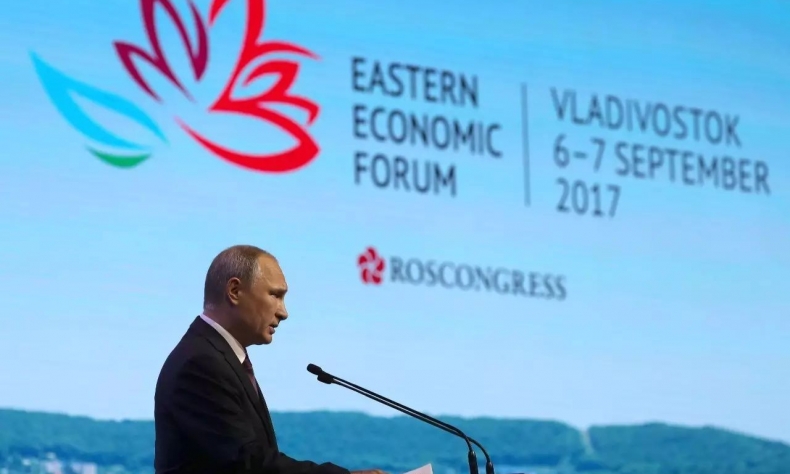The Far East: A New Platform for Sino-Russian Cooperation

Russian officials have thoroughly evaluated the results of previous EEF meetings and believe that it has reached a world-class level.
The fourth Eastern Economic Forum (EEF) with the theme of “The Far East: Expanding the Range of Possibilities,” was successfully concluded on September 13 in the Russian Far East city of Vladivostok. Chinese President Xi Jinping led the Chinese delegation, marking the first time the Chinese head of state participated in the event. The official Russian media reported on the eve of the meeting that there would be some 600 Chinese delegates.
The EEF is a large-scale international conference established by Russian President Vladimir Putin in 2015 that has been held annually in Vladivostok ever since. According to Putin’s vision, the purpose of the forum is to promote the economic development of the Russian Far East and provide a platform for international cooperation in the Asia-Pacific region.
The first three forums achieved satisfactory results, with more and more countries participating and the number of contracts and the level of cooperation continuing to increase. By the third forum, representatives from over 60 countries were in attendance, signing more than 200 cooperation agreements with a total investment of more than 2.5 trillion rubles ($36.6 billion).
Russian officials have thoroughly evaluated the results of previous EEF meetings and believe that it has reached a world-class level. This is because the forum has attracted an increasing number of national leaders and mulinational companies as the Russian Far East becomes a hot spot for international cooperation. The leader of the Ministry for the Development of the Russian Far East pointed out that all projects supported by Vladivostok’s government, both domestic and international, have been discussed by leaders of various countries. What is happening in the Far East has greatly improved the potential of economic cooperation between Russia and the rest of the world.
The fourth EEF was also held in the context of increasing sanctions imposed by Western countries on Russia since the Ukrainian crisis of 2014. Out of a profound global geopolitical perspective, its significance far exceeds the scope of international economic cooperation. By holding large international forums under the theme of international economic cooperation in the Far East which is far from the political center of Moscow, the geopolitical nature of the forum is weakened. This makes it increasingly possible to attract multinational corporations, including those from Europe and the United States. Thus, the forum serves as an answer to Western countries’ sanctions, opening up new opportunies for Russia to expand its economic and diplomatic space.
Far East development has become Russia’s long-term national strategy. Its huge potential is undoubtedly a strong attraction for multinational companies not only in Asia-Pacific countries but also Europe and the United States. This is the perfect fulcrum for Russia to break through the Western economic and political pressure. In addition, the region also contains many regional hot spots, such as the nuclear issue on the Korean Peninsula and the geopolitical and historic issues among China, Japan and Korea. With the influence of the EEF, Russia can also expand its geopolitical influence in Northeast Asia.
As Xi said in his speech, countries in Northeast Asia should build up mutual trust to safeguard regional peace and tranquility; deepen cooperation to achieve mutually-beneficial and win-win outcomes; learn from each other to consolidate their traditional friendship; and take a long-term perspective to realize integrated and coordinated development. Although it was a brief speech, a lot of information was revealed and the four points mentioned are of great importantance. Xi’s visit to Russia is not only a manifestation of the extremely friendly exchanges between the two leaders, but it also shows great support to Russia in a pragmatic and cooperative manner.
The Far East region is the focus of Russia’s development. Since China’s northeast revitalization is very consistent with the Far East development strategy, China may increase its economic investment in the Far East in the future. The Sino-Russian Heilongjiang Bridge that is expected to be completed by 2019 and the port of Heilongjiang Weibin, which greatly enhance complementary advantages between China and Russia, are very good projects for border cooperation to promote interconnection and facilitate trade.
Since the beginning of 2018, the geopolitical pattern in Northeast Asia has undergone unprecedented changes with a number of meetings between the top leaders of China and the Democratic People’s Republic of Korea (DPRK) and the first meeting of the leaders of the DPRK and the United States. The nuclear issue on the Korean Peninsula is also at a very sensitive juncture. At this time, strengthening regional cooperation between China and Russia will also help achieve regional stability in Northeast Asia. The competition among major countries under the overall easing global environment has become more subtle and complicated. As a result, the status of the fourth EEF has become more prominent. In particular, Xi, as the highest national leader from China to attend for the first time, greatly enhanced the reputation of the forum. The cooperation between China and Russia in the Far East will advance to a higher level, i.e. from the past economic and trade cooperation to bilateral strategic cooperation. Apart from expanding pratical cooperation in the traditional areas of energy, transportation, finance, science and technology, education, agriculture, economy and trade, the two countries can also consolidate the stragtegic cooperation in the Far East, and thus promote regional cooperation in the whole Northeast Asia.
Yang Jin, Research Associate, Russian, Eastern European and Central Asian Institute, Chinese Academy of Social Sciences,and the Deputy Secretary General, Research Center of Shanghai Cooperation Organization, Chinese Academy of Social Sciences
Editor: Dong Lingyi
 Facebook
Facebook
 Twitter
Twitter
 Linkedin
Linkedin
 Google +
Google +










